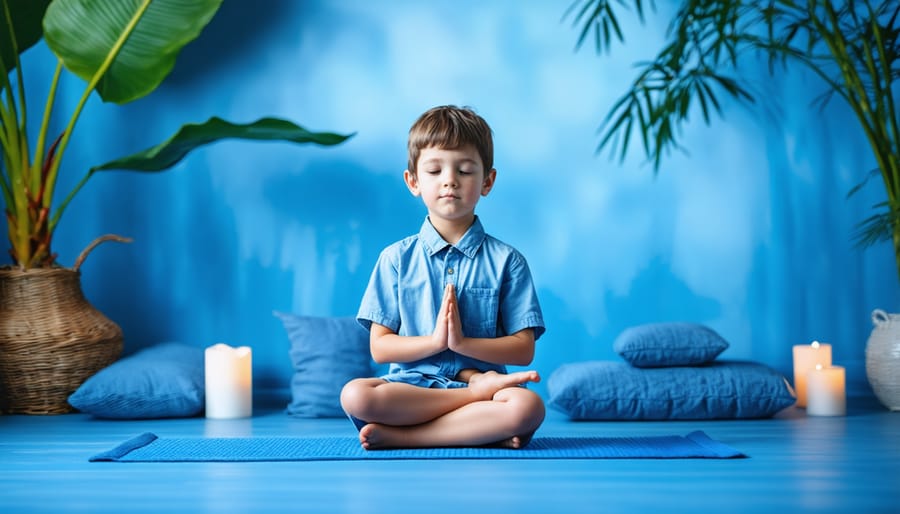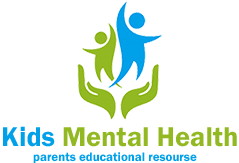Imagine a gentle blue light washing over your child like calm ocean waves, bringing peace to their busy mind. Just as blue spaces transform children’s mental health, blue light meditation offers a scientifically-backed approach to reducing anxiety and promoting emotional balance in young ones.
Recent research from leading pediatric mental health experts reveals that specific wavelengths of blue light, when combined with mindful breathing exercises, can trigger the body’s natural relaxation response. This gentle, non-invasive technique has shown remarkable results in helping children manage stress, improve focus, and develop better emotional regulation skills.
As parents and caregivers, we’re constantly searching for natural ways to support our children’s mental well-being. Blue healing light meditation offers a safe, effective tool that can be easily incorporated into daily routines – whether at home, in the classroom, or during therapy sessions. By combining the soothing properties of blue light with age-appropriate mindfulness practices, we can help our children develop lifelong skills for emotional resilience and inner peace.
The Science Behind Blue Spaces and Child Well-being
Why Blue Colors Calm Children
Scientific research has shown that blue light has a natural calming effect on children’s brains, working through specific pathways in our visual system. When children are exposed to gentle blue light, their bodies respond by reducing the production of stress hormones like cortisol, while increasing the release of calming chemicals that help them feel more relaxed and centered.
Think of it like the peaceful feeling you get when gazing at a clear blue sky or watching gentle ocean waves. Blue light triggers special receptors in our eyes that communicate directly with the part of the brain responsible for regulating emotions and stress responses. Dr. Sarah Martinez, a pediatric neurologist, explains, “Blue wavelengths have been found to activate areas in the brain that promote relaxation and emotional balance, making it particularly beneficial for children who struggle with anxiety or overwhelming feelings.”
This natural response isn’t just psychological – it’s hardwired into our biology. Children are especially responsive to blue light’s calming effects because their developing brains are more adaptable and receptive to environmental cues. The gentle influence of blue light helps create a sense of safety and tranquility, making it easier for children to transition from states of stress or excitement to peaceful alertness.
The Ocean-Mind Connection
There’s something magical about how water environments naturally soothe our children’s minds. Research has shown that the healing power of blue environments goes beyond simple enjoyment – it’s deeply rooted in our biology.
When children spend time near water, whether it’s a peaceful lake, flowing stream, or the vast ocean, their stress levels naturally decrease. The gentle sound of waves, the rhythmic movement of water, and the expansive blue views all work together to create a calming effect on their nervous system.
Dr. Sarah Martinez, a child psychologist, explains, “Water environments activate our parasympathetic nervous system – our body’s natural relaxation response. For children, who are still developing their emotional regulation skills, this natural calming effect is particularly beneficial.”
This connection explains why many children instinctively feel drawn to water and why they often become more centered and peaceful near blue spaces. Understanding this natural relationship helps us appreciate why incorporating water elements into meditation practices can be especially effective for young minds.

Blue Light Meditation Techniques for Kids
Ocean Wave Breathing
Picture yourself sitting by the ocean on a calm, peaceful day. Ocean Wave Breathing is a gentle technique that helps children experience natural anxiety relief by mimicking the soothing rhythm of ocean waves.
Start by having your child sit comfortably, either cross-legged on the floor or in a chair with their feet flat on the ground. Ask them to close their eyes and imagine they’re watching waves roll in and out on a beautiful beach.
As they breathe in through their nose, guide them to imagine a wave slowly building and rising. When they breathe out through their mouth, they can picture the wave gently flowing back into the ocean. The breath should be slow and steady, just like peaceful waves.
Encourage your child to make a soft “whoosh” sound on the exhale, similar to the sound of waves washing onto shore. This auditory element helps maintain focus and deepens the relaxation response.
Practice this breathing exercise for 3-5 minutes, or longer if your child is comfortable. Many parents report that their children find this technique particularly helpful before bedtime or during anxious moments at school.
Remember, just like real ocean waves, each breath doesn’t need to be perfect. The goal is to create a rhythmic, calming pattern that helps your child feel peaceful and centered.

Blue Light Visualization
Find a quiet, comfortable space where you won’t be disturbed. Sit or lie down in a relaxed position, and take three deep, calming breaths. As you breathe in, imagine a gentle, soothing blue light – like a soft summer sky or peaceful ocean waves – slowly filling your body from your toes up to your head.
With each breath, picture this healing blue light growing stronger and warmer. Imagine it flowing through your feet, legs, stomach, chest, arms, and finally reaching the top of your head. As the blue light touches each part of your body, feel any tension or worry melting away like snow in sunshine.
Now visualize yourself surrounded by a peaceful blue bubble of light. This is your safe space, where stress and anxiety can’t reach you. The blue light protects and nurtures you, just like being wrapped in a cozy blanket. Take a moment to feel its gentle, calming energy washing over you.
If worried thoughts come up, imagine them floating away in little blue bubbles. Watch them drift up and disappear into the sky, taking your concerns with them. Stay in this peaceful blue space for as long as you need, knowing you can return to it whenever you feel overwhelmed or anxious.
When you’re ready to finish, wiggle your fingers and toes, take one more deep breath, and slowly open your eyes, carrying that sense of peace with you.
Making Blue Light Meditation Part of Daily Life
Creating a Blue Calm Space
Creating a calming meditation space doesn’t require an elaborate setup. Start by choosing a quiet corner in your home where your child feels safe and comfortable. A bedroom or reading nook often works well. Remove distracting items and electronic devices, keeping the area clutter-free and peaceful.
Use soft blue lighting, which you can achieve through blue LED bulbs, gentle blue night lights, or even blue curtains that filter natural daylight. If possible, paint one wall in a soothing shade of blue or add blue decorative elements like pillows, blankets, or wall art.
Consider adding comfortable seating options like floor cushions, bean bags, or a small yoga mat. Some children prefer lying down, so having a cozy blanket nearby can help them feel secure. You might also include calming elements like a small water fountain, peaceful nature sounds, or aromatic diffusers with child-safe essential oils.
Keep the temperature comfortable and ensure good ventilation. Remember, this space should feel inviting and special to your child, so involve them in setting it up. They’re more likely to use the space regularly when they feel a sense of ownership over it.

When and How Often to Practice
Blue healing light meditation can be practiced at any time of day, though many parents find it particularly effective during transition periods or before potentially stressful situations. For children, consistency is key – aim for short, regular sessions rather than lengthy, sporadic ones.
Start with 3-5 minutes daily, gradually increasing to 10-15 minutes as your child becomes more comfortable with the practice. Many families find success incorporating this meditation into their bedtime routine, as the calming blue light visualization naturally complements wind-down time.
Dr. Sarah Chen, a child psychologist, suggests practicing twice daily: “A morning session can help children start their day feeling centered, while an evening practice aids in releasing daily tensions and preparing for restful sleep.”
Consider these optimal times:
– Before school to reduce academic anxiety
– After school to decompress
– Before homework to enhance focus
– During challenging emotional moments
– As part of the bedtime routine
Remember that every child is different – observe when your child seems most receptive to meditation and adjust your schedule accordingly. The key is making it a regular, nurturing part of your daily routine rather than a rigid obligation.
Supporting Your Child’s Journey
Establishing a regular meditation practice with your child requires patience, consistency, and a gentle approach. Start by creating a calming environment where your child feels safe and comfortable. This could be their bedroom, a cozy corner of the living room, or even a special “meditation spot” they help design.
Make the practice feel like a special bonding time rather than a chore. Consider using positive reinforcement, such as a meditation chart with stickers, to celebrate their commitment. Keep sessions short at first – even just 2-3 minutes can be beneficial for young children.
Listen to your child’s feedback and adapt the practice accordingly. Some children might prefer meditating in the morning before school, while others may find it helpful before bedtime. If your child seems resistant one day, don’t force it. Instead, try making it playful by incorporating their favorite stuffed animals or creating meditation-related stories.
Remember that children learn best by example. If possible, practice alongside them and share your own experiences. This not only helps normalize meditation but also creates precious moments of connection.
For younger children, you might need to guide them more actively through the process. Use age-appropriate language and imagery, like imagining being wrapped in a warm, gentle blue blanket of light. As they grow more comfortable with the practice, gradually encourage them to take more ownership of their meditation journey.
Blue healing light meditation offers a gentle, effective way to support your child’s emotional well-being and mental health. As we’ve explored, this practice can help reduce anxiety, improve sleep quality, and enhance focus – all crucial elements for your child’s development. By incorporating these techniques into your family’s daily routine, you’re giving your children valuable tools they can use throughout their lives to manage stress and emotions.
Remember, every child is different, and it may take time to find the approach that works best for yours. Start small, be patient, and celebrate the small victories along the way. Whether you choose to practice during bedtime, after school, or as a family activity, the key is consistency and creating a safe, nurturing environment.
We encourage you to try these meditation techniques with your children. The benefits of this practice extend beyond the meditation session itself, fostering stronger parent-child bonds and emotional resilience that will serve them well into the future.



